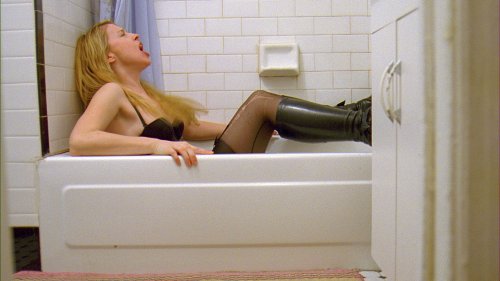Cast: Ruoyun Zhang, Elane Zhong, and Yang Song
Director: Li Yang
98 minutes (15) 2024
Signature Blu-ray
Rating: 7/10
Review by Christopher
Geary
“I hate everything about the grown up world.”
Essentially, a young superheroes adventure, this Chinese movie features time-travel between 1999 to 2019, with frenetic cartoony animations that overlay the frantic pace of many live-action scenes. Three young friends indulge themselves in very often melodramatic fantasies over a potential girlfriend, Yang Yi, a teen goddess who’s attacked and traumatised by a lady ‘terminator’. It’s seemingly inspired by the Street Fighter franchise, bits from Terry Gilliam’s 12 Monkeys, and general tones of 20th Century Boys trilogy (2008-9), when filtered through the mindset of Takashi Miike.
The screen ratio stretches or distorts, almost randomly, including
frequent 1.55:1 video-style inserts, and extreme 3.60:1 letterbox. Yet this hybrid
format is rarely to any good enrichment effect beyond the quirks of hyper-active
stylisation and, occasionally, it’s an erratically impulsive distraction, not a
compelling story-telling device, while deployments of slow-motion or speeding-up
action ensure a maximum visual impact.
Meeting an older self was the main genre theme of Megan Park’s
comedy-drama My Old Ass (also 2024),
but writer-director Yang Li splurges on the content here, without much
subtlety, to enhance any differences between the immature and sometimes
world-weary characters in their respective eras. Divided by millennial angst, nostalgia
might be the friends’ drug of choice, as they grow up to recognise that “Gaming
improves the mind. Addiction destroys the body.”
It’s all happening on a planet where sneezing is the key to time. And, just like in Park’s more modestly composed My Old Ass, future versions of the schoolboys look nothing much like their childhood selves. The discrepancy, and much darker fates for their grown-up versions, that the younger ones never imagined, is all part of this movie’s really wacky sense of humour. Meta-jokes are playful critiques...
“Violence won’t solve anything.”
“That’s because we’ve not unleashed our fury, yet.”
Cue training-sequence flashback.
“What a useless montage.”
Notable inventions? Well, there’s a future Frankensteinian mad scientist with an overheated, apparently easily-transplantable brain, who bets his wife’s life on patient survival. If the movie’s two-minute trailer can put you off seeing this feature, you should probably let it... However, if this looks anything like very exciting fun to you, then go ahead and give this offering of escapism a priority viewing.










































